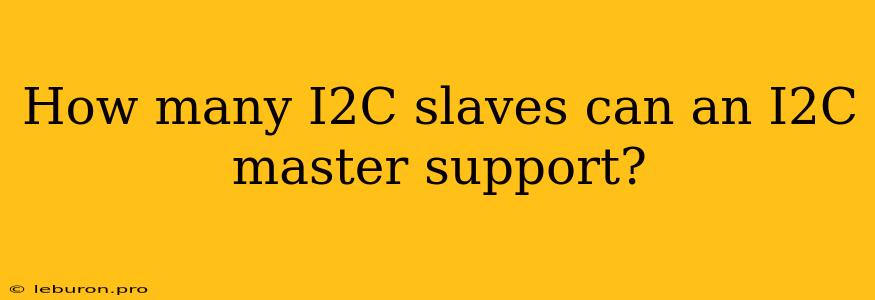The Inter-Integrated Circuit (I2C) protocol is a synchronous serial communication protocol commonly used for communication between microcontrollers and peripheral devices. One of the key aspects of this protocol is the master-slave relationship. An I2C master device controls the communication bus and initiates data transfers, while I2C slave devices respond to the master's requests. A common question that arises is: How many I2C slaves can an I2C master support? This article will delve into the theoretical limits and practical considerations surrounding the number of I2C slaves a master can handle.
Theoretical Limits and Practical Considerations
The I2C protocol itself doesn't impose a strict limit on the number of slaves a master can communicate with. However, various factors come into play, both theoretical and practical, that affect the maximum number of slaves.
Theoretical Limits
-
Address Space: Each I2C slave device has a unique 7-bit address, allowing the master to select the intended slave. With 7 bits, there are 2^7 = 128 possible addresses. However, this number is further reduced by reserving certain addresses for specific purposes. In practice, the available address space for general-purpose slaves is usually less than 128.
-
Bus Capacity: The I2C bus operates at a specific clock frequency, which determines the maximum data transfer rate. With multiple slaves on the bus, the time required for each slave to respond to the master's requests adds up. This can lead to congestion on the bus, especially if multiple slaves are actively communicating. The higher the clock frequency and the more slaves on the bus, the greater the risk of bus contention.
-
Bus Length: The physical length of the I2C bus also plays a role. As the bus length increases, the signal propagation delay becomes more significant. Long bus lengths can lead to signal reflections and distortion, impacting the reliability of communication.
Practical Considerations
-
Device Compatibility: Not all I2C devices are created equal. Some devices may have limitations on the number of slaves they can handle or require specific timing parameters that might not be compatible with other devices on the bus.
-
Bus Load: The overall load on the I2C bus is crucial. This includes factors like the number of active slaves, the frequency of communication, and the volume of data transferred. A high bus load can increase the risk of data errors and decrease overall system performance.
-
Master Device Capabilities: The capabilities of the I2C master device itself are critical. Some masters might have built-in limitations on the number of slaves they can manage, while others may have more sophisticated features that allow them to handle a larger number of slaves effectively.
Maximizing Slave Support
While the theoretical limit might seem high, it's important to understand that practical considerations often limit the number of I2C slaves a master can effectively support. To optimize your I2C system and maximize the number of slaves, consider the following strategies:
-
Choose High-Speed I2C Devices: Utilizing devices that support faster I2C communication speeds can improve bus efficiency and allow for more slaves on the bus without sacrificing performance.
-
Minimize Data Transfer Frequency: If possible, reduce the frequency of data transfers between the master and slaves. For example, use buffering techniques to gather data from slaves periodically instead of constantly polling them.
-
Utilize I2C Bus Extensions: For larger systems with a significant number of slaves, consider using I2C bus extensions. These extend the bus by introducing additional drivers and buffers, allowing you to increase the number of slaves and the physical distance of the bus.
-
Use I2C Multiplexers: I2C multiplexers allow you to connect multiple I2C slaves to a single I2C master. This approach can reduce the load on the bus and simplify system management.
-
Implement Software-Based Strategies: Consider using software-based techniques to manage the I2C bus effectively. For example, implementing a priority scheme for slave access or utilizing message queuing mechanisms can help reduce bus contention and improve communication efficiency.
Real-World Examples
Here are some examples of how the number of I2C slaves a master can support varies in practice:
-
Simple Systems: In simple applications with a few slaves, a single I2C master can typically handle 5-10 slaves without significant performance issues.
-
Embedded Systems: Embedded systems often utilize several I2C slaves for various sensors, actuators, and other peripherals. In such cases, the number of slaves might range from 10 to 20, depending on the specific devices and the desired performance.
-
Industrial Automation: Industrial systems can have many I2C slaves connected to a single master. In these applications, the number of slaves can be considerably higher, reaching tens or even hundreds, depending on the system's complexity and the specific I2C master and slave devices used.
Conclusion
The number of I2C slaves an I2C master can support is not fixed but rather depends on a combination of factors. The theoretical limit is often far higher than what can be achieved in practice due to bus capacity, device compatibility, and other considerations. By carefully considering these factors and implementing strategies to optimize the I2C bus, you can maximize the number of I2C slaves your system can handle effectively. Understanding these concepts is essential for designing reliable and robust I2C systems that meet the demands of your application.
